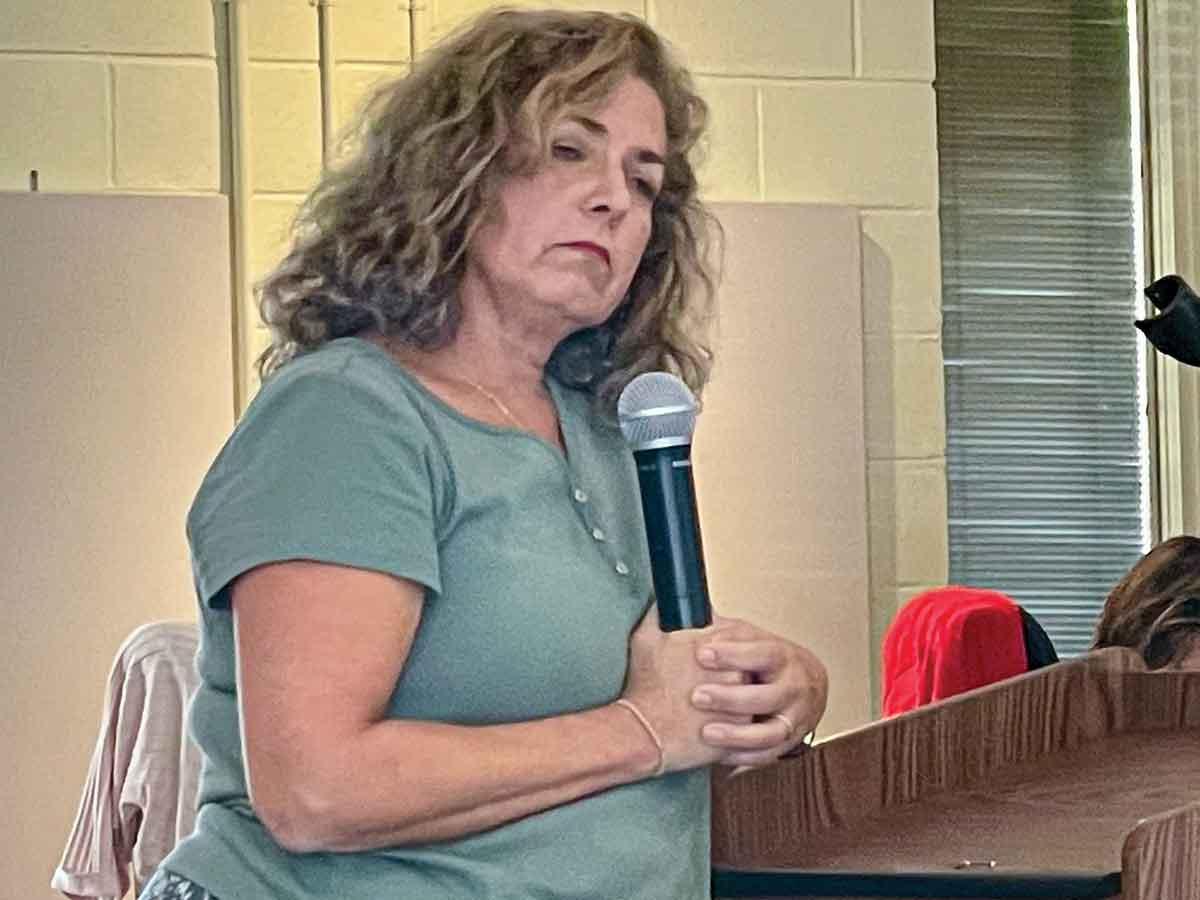Graham Board of Elections dismisses one registration challenge, but the fight’s not over
 Town of Lake Santeetlah Council Member Tina Emerson defends herself against charges of fraudulent voter registration in Robbinsville on Sept. 28. Cory Vaillancourt photo
Town of Lake Santeetlah Council Member Tina Emerson defends herself against charges of fraudulent voter registration in Robbinsville on Sept. 28. Cory Vaillancourt photo
Voters in Graham County can now establish legal residency simply by declaring their “intent” to reside in a particular place, despite overwhelming evidence that they do not actually reside in that place, after a Sept. 28 ruling by the Graham County Board of Elections.
The ruling came at the end of a prolonged 10-hour hearing in Robbinsville, meant to address two of the eight voter challenges filed earlier this year by Lake Santeetlah Town Council Member Diana Simon.
Back in 2021, the results of Lake Santeetlah’s municipal election came as a surprise to residents of the tiny lakeside town, home to both permanent and seasonal residents. In the previous election, only 75 votes were cast (voters could cast up to five votes for five council members), but in the 2021 election, there were almost 130.
Simon identified 11 voters she said were only seasonal residents of the town, and retained Asheville attorney John Noor to bring voter registration challenges against eight of them.
In July, the Graham County Board of Elections held a preliminary hearing during which the board determined that there was probable cause to suspect that the eight individuals had registered fraudulently.
Six of them — Buncombe County veterinarian Dean Hutsell, his wife Linda and their daughters Amelia, Kaylee, Olivia and Savannah — subsequently de-registered in Graham County or re-registered themselves at the Fairview home where it’s alleged they had actually resided all along.
Related Items
The change in registration made the Graham County challenges moot, even though all six Hutsells affirmed in their voter registration applications that they lived at a Lake Santeetlah home that had burned down in 2019 and still does not have a certificate of occupancy from the county.
All six Hutsells voted in the disputed 2021 Lake Santeetlah municipal election from the nonexistent home, and several of them voted in the May 2022 Primary Election from the same address, but since the only relief the Graham County BOE could have provided was to purge the Hutsells from county voter rolls, Simon’s challenges against them have not been scheduled for a hearing.
The course of action taken by the Hutsells suggests that in North Carolina, voters can register at an unhabitable home, vote in multiple elections, and then avoid accountability so long as they re-register at another address prior to any voter challenge proceedings being heard by a county board of elections.
However, the Hutsells have not escaped notice by the North Carolina State Board of Elections.
“The issues raised regarding certain voters registered in Graham County are following the normal course of action prescribed within our laws and the appropriate challenge processes,” said Karen Brinson Bell, executive director of the NCSBE. “We are preliminarily looking into the matter to determine if there were any possible violations of law.”
The remaining two challenges alleged that John and Tina Emerson do not reside at Lake Santeetlah, in one of at least four homes they own in three different states.
Tina Emerson became a member of the Lake Santeetlah Town Council during the disputed 2021 municipal election as one of three challengers receiving 14 votes.
Tina’s registration challenge was taken up first, but got off to a rocky start when she and her husband said they wouldn’t comply with a board subpoena that had asked for records meant to prove their residency — things like drivers’ licenses, credit card statements, phone bills, gas and grocery receipts or loan applications.
Emerson said the Graham County Board of Elections was not authorized to issue such a subpoena and claimed that it was procedurally defective. The board chose not to enforce the subpoena.
After a 20-miunte closed session with Board Attorney Bill Cannon, the board asked Noor if he’d like to proceed without the evidence sought in the subpoena. Once Noor said he would, Cannon established the parameters of the quasi-judicial hearing.
“The board’s decision must be based upon substantial, material, relevant evidence to support the decision,” Cannon said. “’Substantial evidence’ is such relevant evidence as a reasonable mind might accept as adequate to support a conclusion and is more than a scintilla or a permissible inference.”
Noor then set out much of the same evidence he presented during the preliminary hearing, laboriously introducing more than 70 photographs of the Emersons’ lake house taken by Simon and former Mayor Jim Hager that were meant to establish the Emersons’ sporadic presence at the lake.
Other evidence introduced by Noor included tax bills for the Emersons’ lake house from 2016 through 2022, which were sent to the Emersons’ residence in Matthews, outside of Charlotte.
A warranty deed for the Emersons’ Florida property, signed three days after Tina changed her registration to Graham County, lists the Matthews address.
Water bills obtained by Simon show very low usage at the Emersons’ lake house, inconsistent with permanent habitation.
A piece of certified mail sent to the lake house by Simon in March was returned, however an identical mailing sent to the Emersons’ Matthews home was delivered.
The return of certified mail is, per statute, considered prima facie evidence, meaning that in the absence of rebuttal, it’s sufficient to establish the fact that “the person no longer resides in the precinct.”
In the deed of trust for the Emersons’ Matthews residence signed by Tina Emerson, there’s a covenant that explicitly states that the borrowers must use it as “principal residence.”
Likewise, in documents related to the Emersons’ purchase of their lake house at Santeetlah, there’s what’s called a “second home rider,” explicitly stating that the Emersons are only to use the lake house as a second home.
Noor also got Tina Emerson to admit under oath that she was still using the address of her Matthews residence on her driver’s license, in violation of state law.
The Emersons were not represented by an attorney, and throughout the hearing displayed their unfamiliarity with civil procedure. During Tina’s cross examination of Simon, Tina posed compound questions, asked Simon about her own absences from the lake and attempted to testify. Noor’s objections were sustained by Board Chair Juanita Colvard.
From the very beginning, members of the board seemed particularly interested in the “intent” portion of a state statute that reads, “That place shall be considered the residence of a person in which that person’s habitation is fixed, and to which, whenever that person is absent, that person has the intention of returning.”
When the board questioned Simon, they asked how she could know the Emersons’ intent.
Simon said that she had formed her beliefs based upon the documents the Emersons had signed and the promises they had made to lenders regarding the appropriate usage of their properties.
Noor also cited a 1994 Appellate Court case out of Gaston County, Farnsworth v. Jones. In that ruling, the court mentioned a three-part test meant to establish a change in domicile.
First, a person must show “an actual abandonment of the first domicile, coupled with an intention not to return to it.” The Emersons have not abandoned their pre-existing Matthews residence; Tina said they use it like a P.O. box and route all their important paperwork there, despite it being nearly four hours by car from Lake Santeetlah.
The Farnsworth ruling cites a 1972 N.C. Supreme Court case, Hall v. Wake County Board of Elections, which states, “where someone retains his original home with all its incidental privileges and rights, there is no change in domicile.”
Second, a person must show “the acquisition of new domicile by actual residence at another place.” The Emersons did acquire the lake house in 2016, however the documents presented as evidence by Noor contradict the Emersons’ claim of actual residency.
Third, a person must show “the intent of making the newer residence a permanent home.”
Tina Emerson has repeatedly testified that it was indeed her intent to make the lake house a permanent home, ignoring the photo evidence, the water bills, the driver’s license discrepancy, witness testimony from Susan Robinson and the promises she and her husband had made to lenders.
The Hall case, as cited in Farnsworth, casts doubt on the intangible and mutable whims of one’s own heart as decisive evidence of intent.
“We must consider the evidence of all the surrounding circumstances and the conduct of the person in determining whether he or she has effectuated a change in domicile,” it reads.
Throughout the hearing, Tina hammered the “intent” provision, correctly stating that no one could know or prove her intent, one way or the other.
When Tina got the chance to make her case nearly seven hours into the hearing, she attempted to introduce her evidence in the form of photos embedded in a PowerPoint presentation. Noor objected, saying that “pictures of evidence aren’t evidence.”
Board attorney Cannon told her, that if she wanted to project “evidence” onto the screen, she also needed to produce physical copies because they’d be important in the event of an appeal. Tina said she didn’t have any. Her husband John interjected, saying no one had told him to bring physical evidence to a quasi-judicial hearing.
“That’s why you need a lawyer,” Cannon fired back.
Tina offered to print out her PowerPoint presentation and the board authorized a 45-minute recess to allow her to do that. When she returned, she displayed photographs of her husband raking leaves, and a puppy wearing a scarf as evidence that they’d spent time at the lake.
Tina Emerson stumbled through the rest of her presentation, calling irrelevant witnesses and asking irrelevant questions, as evidenced by Colvard sustaining many of Noor’s objections. She also presented evidence that had been requested by the board in the subpoena but was not provided to Noor prior to the hearing.
Noor objected, positing that Tina couldn’t cherry pick beneficial items to produce while at the same time hiding items that might undermine her case. Colvard overruled him.
Nearly 10 hours into the hearing, Noor began his closing statement. Tina objected to it, prompting laughter in the boardroom, but when he resumed Noor summarized relevant law, important cases and the mountain of evidence presented that day.
“Actions speak louder than words. What someone does means a whole lot more than what they say,” Noor told the board. “That’s not just me that says that, that’s what the Court of Appeals says.”
Tina, in her closing statement, said, “When I registered to vote, I read the statute and I read the application and the application says that I intend to reside here and that I will be here 30 days before an election and that I have a right to register and vote.”
Immediately, the board began public deliberations that lasted maybe three or four minutes. Board member Lowell Crisp said he had concerns over how the statute was written, and that it might need to be revised.
“I can see how and understand how one could see that someone might be ineligible because they’re not at a particular place as much as we would like them to be,” Crisp said. “Nevertheless, as a board member we’ve got to go by what we think is the law, as much as we can and whether we like it or not, the law relies a lot on intent.”
Keith “Beefy” Rogers said he could see both sides of the argument, but that the law needs to be more specific with regard to intent.
No other board members spoke. Crisp moved for dismissal of the challenge. Board member Teresa Eller seconded the motion, and fellow member Billy Dittmore joined Crisp, Eller, Rogers and Colvard in voting for dismissal.
Due to the late hour, the challenge against John Emerson was continued to an unspecified future date, although Noor said he’d ask the board to go to court to compel John Emerson to comply with the board’s subpoena.
After the decision, Noor provided some insight into how his clients felt about it.
“My clients, they are disappointed, as you might expect,” Noor said. “However, they respect the board, they appreciate the members taking the time to hear this case and the time they spent evaluating the challenge.”
Diana Simon, the council member who filed the challenges, expressed that disappointment on Oct. 3.
“Elected officials around North Carolina have been following this case closely. Residents and homeowners in Santeetlah have been overwhelmingly supportive. We all expected Graham County officials to follow North Carolina voter registration law. But they did not,” Simon said. “I respect the time the board members took to listen to my case, but unfortunately they ignored the law and the evidence showing that Ms. Emerson doesn’t live in Graham County. We look forward to having a Superior Court judge reverse the board’s decision on appeal.”
Editor’s note: When reached for comment, John and Tina Emerson were not available to conduct an interview.













